Union Grove, WI -- Well once again Jeff Prock of Applied Nitrous Technology has proven that he is the baddest man in nitrous oxide. Jeff has been working on some hot new set-ups over the winter and he turned one of them loose on the Pelech Bros. Racing Super Modified Camaro. On our first full nitrous pass, Jeff picked up right where he left off… 7.906 @ 176 MPH… Pretty darn good considering that he was starting completely over on this new engine combination of ours. Another thing to consider is that the NSCA rules only allow for a 1-stage nitrous system. 7.90 on the first go with a single hit of spray… Great work, Jeff!
But before we get into all of that, let’s back up a few weeks to the Cecil County, Maryland race.
As far as the NSCA’s Cecil County Dragway race goes… We’ll just forget that that one even happened and leave it at that. No… You know what… On second thought… Here’s a run down of our struggles.
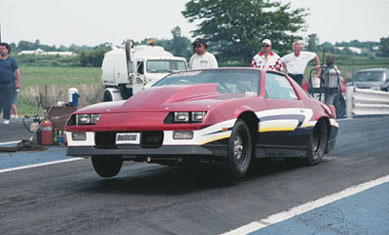 That race was a battle for us from day one. As we were preparing to leave, nothing was going well. We figured things would go better when we got to the track… They didn’t… On warm-up, we were experiencing oil pressure fluctuations and the engine seemed to be laboring. A check of the oil showed a few shiny little flakes. Huh! I’ve seen this before… Great! It’s trying to spin a bearing… We immediately put the engine on the hook and trollied it into the trailer for exploratory surgery. We pulled the bottom end apart searching for the snagged bearing. Hmm… None to be found… The bearings all looked perfect. Now what? Who knows… Put it back together… If we hurry, we can still make third round qualifying.
That race was a battle for us from day one. As we were preparing to leave, nothing was going well. We figured things would go better when we got to the track… They didn’t… On warm-up, we were experiencing oil pressure fluctuations and the engine seemed to be laboring. A check of the oil showed a few shiny little flakes. Huh! I’ve seen this before… Great! It’s trying to spin a bearing… We immediately put the engine on the hook and trollied it into the trailer for exploratory surgery. We pulled the bottom end apart searching for the snagged bearing. Hmm… None to be found… The bearings all looked perfect. Now what? Who knows… Put it back together… If we hurry, we can still make third round qualifying.
We re-installed the engine and pulled out of the pits just as the first pair of our fellow Super Mods made their passes. I blasted up the return road to the staging lanes… A spectator later commented that my run up the return road was faster then some of the runs down the track… Anyhow… Prock lined me up in the water and gave me the signal to light the tires. I guess I did a little too wild of a burn-out. Tim and Todd were looking at me with the stink eye and when Prock opened the door to turn on the nitrous and start the data-acq, he also added "scold driver for wild burn-out" to his list of pre-staging activities. He then slammed the door shut in disgust and walked away. I still don’t think the burn-out was that bad… But nobody else seems to agree with me. I guess I’ll have to be a little more careful on the burn-outs…
So I begin to roll forward to stage the car. All the sudden I heard a racket from the engine and I quickly shut the car down to avoid further damage. That was it!!! WE ARE GOING HOME! "But don’t you want to see what that racket was?" NO! "We’ll just pull the valve covers and take a quick peek…" NO!
On the tow back to the pits, a curious thing happened… I noticed a strange noise coming from the back of the car… Hmm… What’s that? We’ll check that out when we get home…
Saturday night, we began tearing down the Pelech Bros. Racing compound as Todd whipped up a couple of his "Bett’s Bar-B-Qued Buzzards" that he had been SO highly touting all weekend. Mmm, Mmm, Good! Not bad, Todd… I knew there was a reason we let you hang out with us…
Sunday morning we began the trek home.
When we returned to Mission Control, we tore-down the engine. So what was all of the racket that was heard? Nothing more then a exhaust rocker arm that had cleanly broke it’s shaft bolts. (Rowdy cam, I guess…) $10 in stainless steel bolts shut our engine off. I’m just happy that’s all it was. It could’ve been much worse. Imagine if that had broke in the middle of the heavily nitrous’d run. The exhaust valve would have become non-functional making the intake valve become both an intake and exhaust valve. This certainly would have blown the manifold completely off the engine, thrown it through the windshield, and into the car with me. None of us would have been happy…
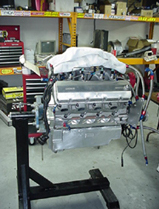
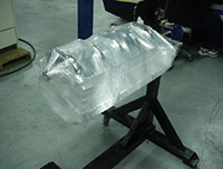 After the tear-down was completed, I then ran the block over to Hutch’s Transmission Service. Hutch utilized all of his ultra hard-core cleaning equipment to assure that no debris would be left inside the engine block. Now I can understand how Hutch can be such a clean freak. That thing was spotless! You can certainly be assured that the racing transmission you buy from Hutch’s Transmission Service is internally sanitary. The engine was reassembled shortly there after and placed back in the car, minus the oil pump, which was sent out to be serviced.
After the tear-down was completed, I then ran the block over to Hutch’s Transmission Service. Hutch utilized all of his ultra hard-core cleaning equipment to assure that no debris would be left inside the engine block. Now I can understand how Hutch can be such a clean freak. That thing was spotless! You can certainly be assured that the racing transmission you buy from Hutch’s Transmission Service is internally sanitary. The engine was reassembled shortly there after and placed back in the car, minus the oil pump, which was sent out to be serviced.
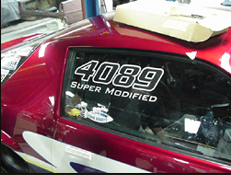
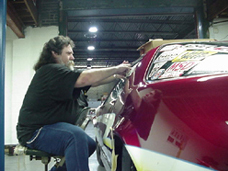 As that was taking place, Gary Law of Bear Race Graphics was applying the hot new car number and class designation decals that he whipped up. Gary also delivered the new Pelech Bros. Racing decals. Be sure to stop by our trailer to get yourself one… Bear Race Graphics has years of experience in race graphics design and application. They have an endless selection of incredible materials on hand. Be sure to stop by www.bearracegraphics.com to have a look at what they can do for you.
As that was taking place, Gary Law of Bear Race Graphics was applying the hot new car number and class designation decals that he whipped up. Gary also delivered the new Pelech Bros. Racing decals. Be sure to stop by our trailer to get yourself one… Bear Race Graphics has years of experience in race graphics design and application. They have an endless selection of incredible materials on hand. Be sure to stop by www.bearracegraphics.com to have a look at what they can do for you.
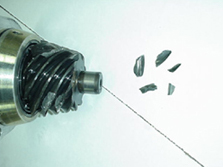 Now we needed to determine what the noise was in the axle assembly. We didn’t have much time before leaving for the re-scheduled NSCA race in Union Grove, WS. I really didn’t want to tear the axle apart due to the lack time, but we had little choice. We had to figure out if something was wrong. And it was! As soon as I pulled the plug to empty the gear oil from the center section, I heard two clanks in the bottom of the drain pan. What the… What was that? I fished through the ganky old gear lube and, much too my surprise, what should I find? TEETH! How cool… We finished pulling the center section out and discovered three teeth were missing from the pinion gear. All of the other teeth were severely cracked. Well, I guess we ran that gear a little too long…
Now we needed to determine what the noise was in the axle assembly. We didn’t have much time before leaving for the re-scheduled NSCA race in Union Grove, WS. I really didn’t want to tear the axle apart due to the lack time, but we had little choice. We had to figure out if something was wrong. And it was! As soon as I pulled the plug to empty the gear oil from the center section, I heard two clanks in the bottom of the drain pan. What the… What was that? I fished through the ganky old gear lube and, much too my surprise, what should I find? TEETH! How cool… We finished pulling the center section out and discovered three teeth were missing from the pinion gear. All of the other teeth were severely cracked. Well, I guess we ran that gear a little too long…
I’m kind of glad we didn’t get to make a run at Cecil County. It could have been disastrous. Best case scenario: Pinion breaks at launch and destroys entire rear end assembly. Worst case scenario: Pinion breaks at the top end and I crash destroying the entire car. We’re all pretty glad that we didn’t have to find out.
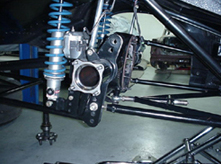 Now we were in full panic mode to get a ring & pinion and to re-assemble the rear end. While the center section was apart, Tim decided that now was the time to make the switch to a large pinion set-up. He quickly ordered up a fresh Pro gear and all of the other necessary components to complete the conversion. Tim assembled the center section and we hastily slapped it into the housing and finished re-assembling the rear end.
Now we were in full panic mode to get a ring & pinion and to re-assemble the rear end. While the center section was apart, Tim decided that now was the time to make the switch to a large pinion set-up. He quickly ordered up a fresh Pro gear and all of the other necessary components to complete the conversion. Tim assembled the center section and we hastily slapped it into the housing and finished re-assembling the rear end.
We are ready for Union Grove!
What a peach of a track! Bumpy, wavy, slippery, nasty up-hill (nearly vertical) water box, rough/short/down-hill shut off area, and those oh-so-friendly race car shredding Armco guard rails… Those rails scare me too death… And if you hit one of them at speed, that’s where you’ll end up… Dead.
No matter… These are the cards we were all dealt, so these are the cards we’ll play…
Let’s fire it up!
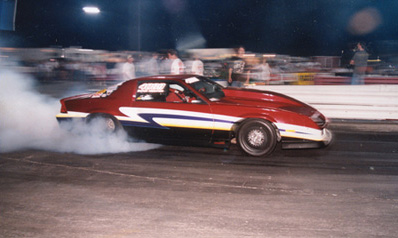 In order to seat the rings and such, we made several non-nitrous passes during the Friday evening test session. Don’t ask how fast (or in this case, how slow) it went… Let’s just say that off the nitrous, our car is a bit of a slug and we’ll leave it at that...
In order to seat the rings and such, we made several non-nitrous passes during the Friday evening test session. Don’t ask how fast (or in this case, how slow) it went… Let’s just say that off the nitrous, our car is a bit of a slug and we’ll leave it at that...
After a couple of passes, the cylinders were drying up and sealing nicely. All of them except for Cylinder #4. #4 had oil on the spark plug and it just didn’t seem like it was going to be going away. We weren’t going to be able to give #4 any nitrous until the oil was gone. This is where the irresponsible speculation began. Where was the oil coming from? Faulty valve guide or seal? An overlapped or broken expander in the oil ring stack? Maybe the intake port was sucking oil from the lifter valley through a ripped intake gasket… Hmm…
Due to lack of time, Prock made the executive decision to cut the nitrous to #4 and add a touch of fuel as a precaution. In the mean time, we hoped that #4 would dry up somewhere along the way so that we could add nitrous to it then. The other 7 cylinders would get Dr. Prock’s fully prescribed dosage. Basically, we would qualify & race on 7 ½ cylinders and we’d just fix the problem when we got home.
OK, So how’d it run?
The first round of qualifying netted us a respectable 8.19 at about 171 MPH. Not bad considering the circumstances. It spun the tires pretty bad at the top of 1st and 2nd gear, which was surprising considering that we were a bit down on power.
At that point, we made a couple of minor suspension adjustments to loosen the car up in search of a bit more bite. It was definitely a move in the right direction. The car picked up a .10 to post an 8.09 ET at almost 172 MPH.
A quick check of the #4 spark plug showed that the oil situation wasn’t improving… It was getting worse. So now what? Tim and Prock had a brief discussion regarding what the course of action would be. Tim predicted that the 3rd round would be rained out and with that, we could get an early start on ripping the engine apart. They made the decision to immediately pluck the engine so that the exact origin of the oil could be determine. Tim was right. The rain moved in, suspending the rest of the evening qualifying. As it turns out, the expander in the #4 oil ring stack had broken. So we reached into our magic box of spare oil rings and promptly replaced the broken one.
Saturday morning we made our 3rd and final qualifying pass. I was surprised that we were given the third pass. I thought for sure that the NSCA officials would set the field with two rounds of qualifying under our belts.
Atmospheric conditions changed dramatically over night. The sweltering 90 degree temperatures had plunged to the low 60’s. This would make for some interesting tuning and track conditions.
I aborted our 3rd qualifying pass when the car made a move for the centerline. It wasn’t all the car’s fault though... When I staged the car, it wasn’t exactly straight. It was sort of pointing somewhat toward the centerline. In fact, from what the guys said, I just plain parked the car side ways in the staging beams. That, coupled with a phat wheelie from having eight healthy cylinders, was all that was needed to waste a run. I did learn this though, the front suspension would definitely have to be tightened up before eliminations.
We were seated in the #8 slot at the conclusion of qualifying. A look at the qualifying sheets showed 28 cars! Outstanding! Better yet, it was 28 tightly qualified cars! The NSCA is definitely doing something right. We were 8th out of 28 with some relatively mild tune-ups! Darn shame that I blew that 3rd qualifying pass. With all of the cylinders now firing, we likely could have slipped up a couple of notched on the qualifying list. No doubt, some excellent racing was going to be in store.
The 1st round of eliminations was a uneventful and clean pass. The car was half way well behaved on the launch and boogied down the track with some tolerable wheel spin. The result was a nice 7.906/174MPH pass for the 1st round win.
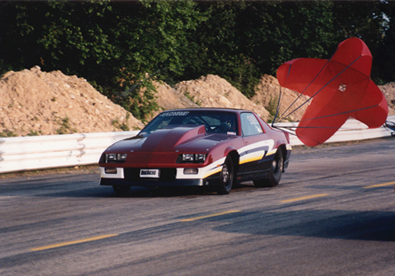 In round 2, the story was a little different. At the release of the trans-brake, the car violently struck the tires. The pass was an ugly one from start to finish. Fortunately for us, our competition had problems of their own and were unable to complete the run. We dodged a bullet there…
In round 2, the story was a little different. At the release of the trans-brake, the car violently struck the tires. The pass was an ugly one from start to finish. Fortunately for us, our competition had problems of their own and were unable to complete the run. We dodged a bullet there…
We made some radical front suspension adjustments preceding the 3rd round. After blowing the tires off in the 2nd round, we had to do something to get a hold of the track. The track officials had sprayed traction compound on the racing surface in an attempt to improve the conditions of the left lane. I didn’t think that it would help much. My thoughts were that the left lane was just too far gone at that point.
In the 3rd round the car launched with a fury! It hoisted the front wheels way up. Cool! I thought, "Wow, that’s not what I expected…" I figured with as bad as the left lane is, the car will just blow the tires off. Wrong! Much like our 1st eliminations pass in Atlanta last year (see "2000 Season"), the car rocked back on onto the wheelie bars with enough power to unload and shake the rear tires. In order to settle the car down, I was forced to shift the car about 2,000 RPM early. This is well below where the engine is happiest running. It is also the exact spot where the pistons like to melt if the engine labors for too long. Thanks to our new cam shaft profile, no pistons were burned and the engine didn’t really labor all too bad. Unfortunately though, the time that was lost by short shifting and fighting with car was all that our competitor needed to stick a car length on us and keep it. Our slowing 7.98/176 MPH pass just wasn’t enough. We were defeated in the 3rd round. We missed out on our opportunity to whack one of the heavy weights of the class. It was a race that we could have and should have won. With a little more fine tuning on the suspension, I’m sure we’ll be right on our game and next time the competition won’t be so lucky. Hah!
Many thanks go out to EVERYONE who helped us prepare for, and race, the Union Grove event. We’d especially like to thank Tony & Mike Flosky and their families. Those guys are the titanium back bone of our operation. No lies! With out them, none of this would be possible!
We’d also like to thank Todd and Amy Betts for all of their assistance in Union Grove. They were relentless in their pursuit of mechanical excellence. And yes, Amy did a lot work on the car… Don’t mess with her… She’s a bad woman! Give her any guff and she’ll show you the painful side of 75 ft/lbs as she applies the torque wrench to your skull.
Thanks to Jeff Prock of www.appliednitroustechnology.com for the obvious!
Thanks to John Hutchinson for all of the un-ending support you’ve shown this operation.
Thanks to Todd Ryden of MSD Ignition for bailing us out of a tough ignition situation on VERY short notice.
Thank you Fast Times Motorworks for all of your fantastic support.
Lastly, I have got to thank my brother, Tim. No matter how many times I disappoint him, walk on him, make unreasonable requests of him, tick him off, or just plain abuse him or let him down. He continues to put everything he has, mentally, physically, and financially, into what we do. How one person can withstand so much punishment, I’ll never know… Without Tim, all of this would be gone… So to my one and only brother, I’m sorry and thank you…
So what’s next? Cordova, Illinois…
Pelech Bros. Racing has declared WAR!
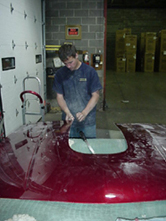
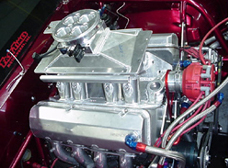 We are knee deep in a pile of changes as we head into battle at Cordova Dragway. (A race that we are going to win!) Tim has nearly completed the hood scoop conversion project. Just a few more details and he’ll have that done… This ought to released the choke hold that has been placed on the induction system of our engine…
We are knee deep in a pile of changes as we head into battle at Cordova Dragway. (A race that we are going to win!) Tim has nearly completed the hood scoop conversion project. Just a few more details and he’ll have that done… This ought to released the choke hold that has been placed on the induction system of our engine…
And we’ve called in reinforcements! By the time you read this, our sheet metal intake will have been fitted by Steve Sanchez at Total Flow Products and on it way to Applied Nitrous Technology to have all of the necessary nitrous oxide and fuel system hardware installed by Jeff Prock. We’re going BIG! Everybody be cool, more power is on the way!
The Hutch’s Transmission Service TH-400 and supporting hardware is already loaded in the Pelech Bros. Racing Mobile Command Center. The 400 trials will take place during the Friday evening pre-race test session at Cordova. We are certain that once we get a grasp on this new driveline set-up, and it’s suspension setting requirements, the results will be tremendous. Just another portion of our "Scorched Earth" strategic initiative…
Any of our parts that will need to be coated before going to battle, will be sent directly to Bad Bill Walker over at QC Coatings. As Bill’s motto goes… "You make fast and we’ll make it pretty!" Oh, it’ll be fast alright and know doubt Bill will have it looking pretty…
That’s all to report for now… Another report from the front line trenches to follow the NSCA’s Cordova battle… I mean… Race…
Over and out!
Ted & Tim Pelech
Pelech Bros. Racing

